Witnessing a majestic hawk soaring gracefully across the sky is a captivating sight. However, there are instances when these solitary birds of prey defy their solitary nature and congregate in large numbers.
The phenomenon of hawks gathering in large groups, known as a kettle or a boil, has fascinated both bird enthusiasts and scientists alike.
In this article, we delve into the reasons why do hawks gather in large groups and explore the intriguing dynamics of hawk grouping.
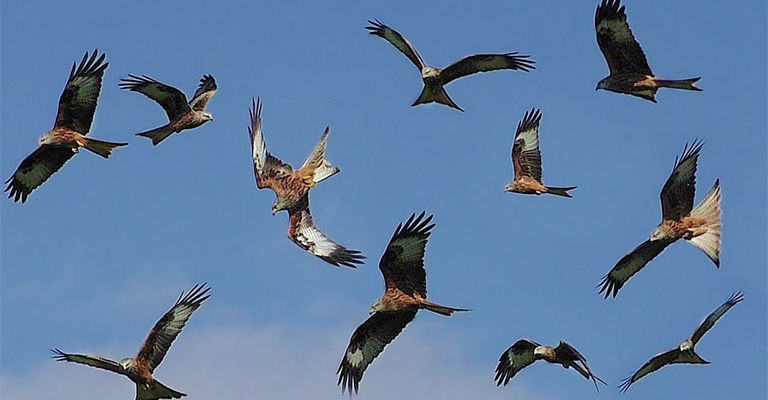
Why Do Hawks Gather in Large Groups?
Below are the reasons why hawks gather in large groups:
Navigation and Migration
One of the primary reasons hawks gather in large groups is navigation and migration. Hawks are highly skilled migratory birds, embarking on long journeys across continents to reach their preferred breeding or wintering grounds.
During migration, they often encounter obstacles such as large bodies of water or mountain ranges, which require substantial effort and energy to overcome. Grouping together allows hawks to capitalize on the collective strength of the group, making the journey more efficient.
Thermals and Updrafts
Another vital factor that contributes to hawk groupings is the utilization of thermals and updrafts. Thermals are columns of warm air that rise from the ground due to heating by the sun. Hawks take advantage of these thermals, circling within them to gain altitude without expending much energy.
By grouping together, hawks can find and exploit these thermals more effectively, leading to greater upward lift and sustained flight. This behavior enables them to conserve energy during long flights and cover greater distances.
Social Bonding and Information Exchange
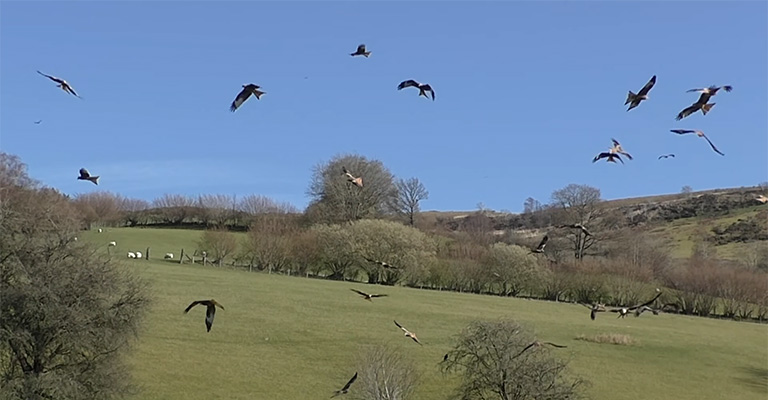
Hawk groupings also serve as opportunities for social bonding and information exchange. Though primarily solitary creatures, hawks exhibit a certain level of social behavior during these gatherings. They communicate through visual displays and vocalizations, strengthening social ties within their species.
Furthermore, these groupings provide opportunities for young or inexperienced hawks to learn from older, more skilled individuals. By observing and mimicking their behaviors, the younger hawks can enhance their hunting techniques and survival skills.
Safety in Numbers
Safety is an essential aspect of hawk groupings. By flying together in large numbers, hawks reduce the risk of predation. Potential predators, such as eagles or owls, may find it challenging to target a single hawk amidst a dense group.
In addition, hawks benefit from the collective vigilance of the group, as more individuals scanning the surroundings increase the chances of spotting potential threats.
Thus, the safety provided by group formations allows hawks to focus on other activities, such as hunting or resting, with reduced risk.
Feeding Opportunities
Food availability also plays a role in the clustering of hawks. During certain times of the year, such as when large numbers of migratory birds pass through an area, hawks gather in anticipation of plentiful feeding opportunities.
The abundance of prey, combined with the efficient hunting techniques learned from each other, increases the chances of successful hunting. By joining forces, hawks can maximize their hunting success and secure an adequate food supply.
What Does It Mean to Flock?
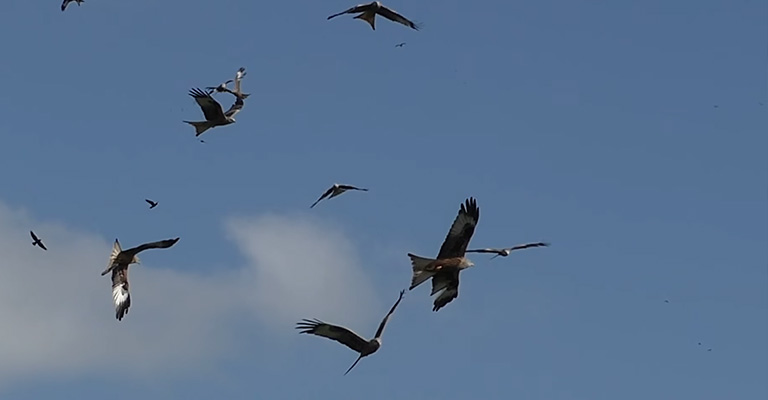
To flock means for a group of animals or birds to come together and move as a cohesive unit. Flocking behavior is commonly observed in various species, including birds, sheep, fish, and insects.
Flocking serves several purposes, including safety, communication, and resource acquisition. In the context of birds, flocking refers to the formation of a cohesive group where individuals fly, feed, or roost together.
Flocking behavior can vary depending on the species and the situation. Birds that exhibit flocking behavior often display coordinated movements, such as flying in a synchronized manner or changing direction simultaneously. Flocking provides several advantages to the participating individuals:
Safety and Predation Avoidance
Flocking reduces the risk of predation. The presence of a larger group makes it more challenging for predators to single out and capture an individual within the flock.
The collective vigilance of the group also enhances predator detection, as more individuals can scan the surroundings for potential threats.
Foraging Efficiency
Flocking can increase foraging efficiency. Large groups of birds can locate food sources more effectively by sharing information and cooperating in locating and capturing prey.
This can be especially beneficial when searching for scattered food items or when feeding in environments with limited resources.
Social Bonding and Communication
Flocking behavior allows individuals to establish and maintain social bonds within the group. Birds communicate with each other through visual displays, vocalizations, and body language, enabling coordination and cohesion within the flock.
Communication within the flock helps individuals stay together, coordinate movements, and share important information.
Migration and Navigation
Many bird species exhibit flocking behavior during migration. Flying in a flock provides advantages such as conserving energy by utilizing the aerodynamic benefits of drafting behind other individuals.
Flocking also assists in navigating challenging or unfamiliar landscapes, as multiple birds can contribute to finding optimal routes and landmarks.
Examples of bird species that flock include starlings, which create breathtaking murmurations, where thousands of birds fly together in intricate and synchronized patterns.
Geese also form large flocks during migration, flying in V-shaped formations that reduce wind resistance and enable efficient long-distance travel.
Do Hawks Flock?
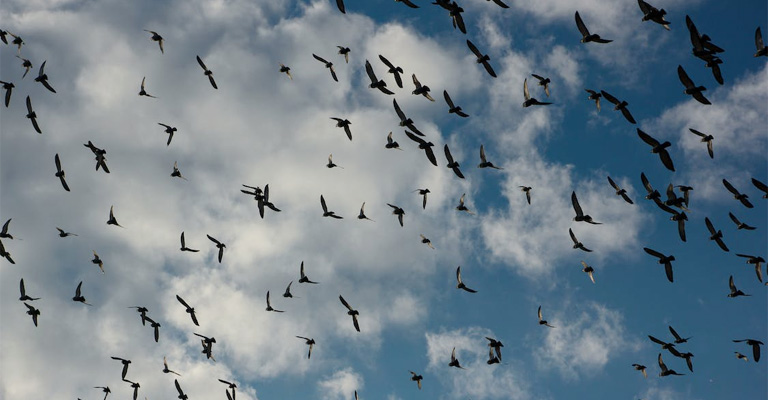
While hawks are generally known to be solitary birds, there are certain situations where they may exhibit flocking behavior.
Hawks do not typically form large flocks like some other bird species, but they may congregate in smaller groups or loose aggregations for specific purposes.
These gatherings are typically observed during migration, feeding opportunities, or in communal roosting sites.
Migration
During migration, some hawk species display a behavior known as “kettling” or “boiling.” This behavior involves groups of hawks soaring and circling together in thermals (updrafts of warm air) to gain altitude and facilitate their long-distance journeys.
While not a tightly organized flock, these groups can consist of dozens or even hundreds of hawks, particularly in species like the Broad-winged Hawk. Kettling allows hawks to conserve energy and take advantage of the rising air currents.
Feeding Opportunities
In areas with abundant food sources, such as during the movement of migratory birds or during large-scale insect emergences, hawks may gather in loosely associated groups to exploit the available prey.
These gatherings provide a higher chance of successful hunting and can lead to temporary aggregations of hawks in a specific location.
Communal Roosting
Some hawk species, such as Red-tailed Hawks and Swainson’s Hawks, may engage in communal roosting. In these cases, multiple hawks select a shared roosting site, often in trees or on cliffs, where they gather to rest or sleep.
While the individuals may not actively interact or fly together, they coexist in the same area for the purposes of safety, warmth, and social interaction.
It is important to note that these instances of hawks gathering do not imply the same level of coordination or cohesive behavior observed in some other flocking species.
Hawks remain primarily solitary birds, and their gatherings are typically more loosely structured and temporary compared to the tight-knit flocks of other bird species.
Do Hawks Fly in Groups?
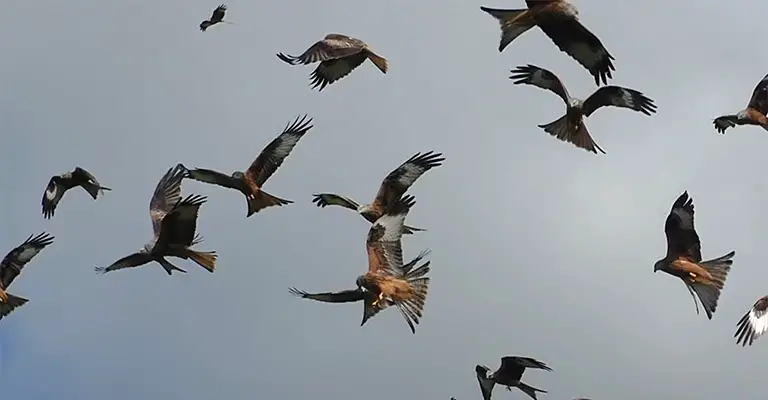
Hawks generally fly as solitary birds, and their natural behavior involves independent flight. Unlike some bird species that form large, coordinated flocks, hawks typically prefer to fly alone.
Solitary flight allows hawks to utilize their exceptional hunting skills and focus on locating and capturing prey. However, there are situations where hawks may be observed flying in groups or in proximity to other hawks.
These instances are more accurately described as loose aggregations or interactions rather than true flocking behavior. Here are a few scenarios where hawks may be seen flying in groups:
Migration
During migration, some hawk species engage in a behavior called “kettling” or “boiling.” This phenomenon involves groups of hawks soaring and circling together in thermals (rising columns of warm air) to gain altitude and facilitate their long-distance journeys.
While they are flying in proximity to each other, it is important to note that the hawks in these groups are typically focused on their individual flights and do not exhibit coordinated or synchronized movements like true flocking species.
Feeding Areas
When there is an abundance of food in a particular area, such as during the movement of migratory birds or during insect swarms, hawks may gather in the same vicinity.
These gatherings can lead to multiple hawks flying in the same general area as they search for prey. However, each hawk maintains its independent flight and hunting strategies.
Territory Interactions
In certain circumstances, hawks may interact in the air due to territorial disputes. When defending their territories or nesting sites, hawks may engage in aerial displays, chasing, or occasional physical confrontations with other hawks.
These interactions can involve multiple hawks flying in close proximity to each other, but they are driven by territorial defense rather than cooperative flight.
Hawks That Don’t Flock
Hawks are generally solitary birds that do not exhibit true flocking behavior. They typically prefer to hunt and fly alone. While some hawk species may gather in loose groups during migration, feeding, or communal roosting, these gatherings are not comparable to the coordinated flocking behaviors observed in other bird species.
Here are a few examples of hawks that are known to be solitary:
Red-tailed Hawk (Buteo jamaicensis)
The Red-tailed Hawk is a widespread and well-known hawk species in North America. It is primarily a solitary bird, often seen soaring alone in search of prey. Red-tailed Hawks establish and defend territories, and they typically fly, hunt, and nest individually.
Cooper’s Hawk (Accipiter cooperii)
Cooper’s Hawks are agile and swift woodland hawks known for their skillful pursuit of birds. They are solitary hunters, preferring to stealthily fly through forests and surprise their prey individually. While they may share territories with other Cooper’s Hawks, they do not flock together.
Sharp-shinned Hawk (Accipiter striatus)
Similar to the Cooper’s Hawk, the Sharp-shinned Hawk is a small and agile woodland hawk. It is known for its exceptional maneuverability while hunting birds in dense cover. Sharp-shinned Hawks are solitary birds and primarily engage in independent flight and hunting.
Harris’s Hawk (Parabuteo unicinctus)
Unlike many other hawk species, Harris’s Hawk displays a unique social behavior known as cooperative hunting. While not true flocking, these hawks may hunt in small groups, often consisting of family members.
Cooperative hunting allows them to work together to capture larger prey, but they typically disperse and fly alone outside of hunting activities.
It’s important to note that while these hawks are predominantly solitary, they may interact with other hawks in specific situations, such as during courtship displays or territorial disputes.
FAQs
No, not all hawk species gather in large groups. While some species, such as the Broad-winged Hawk (Buteo platypterus), are known for their remarkable group formations during migration, others tend to be more solitary in nature.
Hawks communicate within a group through various means. They employ visual displays, such as wing movements or aerial acrobatics, to convey messages and establish social hierarchies.
While hawk groupings are commonly observed during migration periods due to the aforementioned reasons, they can also occur outside of migration. For instance, during periods of abundant food supply or when certain weather conditions create favorable thermal updrafts, hawks may congregate in larger numbers.
Although hawk groupings offer advantages, there can be some risks associated with this behavior. Large concentrations of hawks in one area may deplete local food resources, leading to intensified competition among individuals. Additionally, infectious diseases or parasites can spread more easily within dense populations, posing health risks to the Hawks.
Observing hawk groupings can be a rewarding experience for bird enthusiasts. To witness these gatherings, it is beneficial to locate areas where hawks are known to migrate or where they have access to thermals for soaring.
Final Words
So, now you know why hawks gather in large groups. The phenomenon of hawks gathering in large groups remains a captivating aspect of their behavior. Navigation and migration, utilization of thermals, social bonding, safety in numbers, and feeding opportunities all contribute to the formation of these clusters.
By understanding the reasons behind hawk grouping, we gain a deeper appreciation for the complexity and adaptability of these magnificent birds.
As we continue to study and unravel the secrets of their behavior, the awe-inspiring sight of hawks soaring together in unison will continue to captivate both scientists and nature enthusiasts alike.